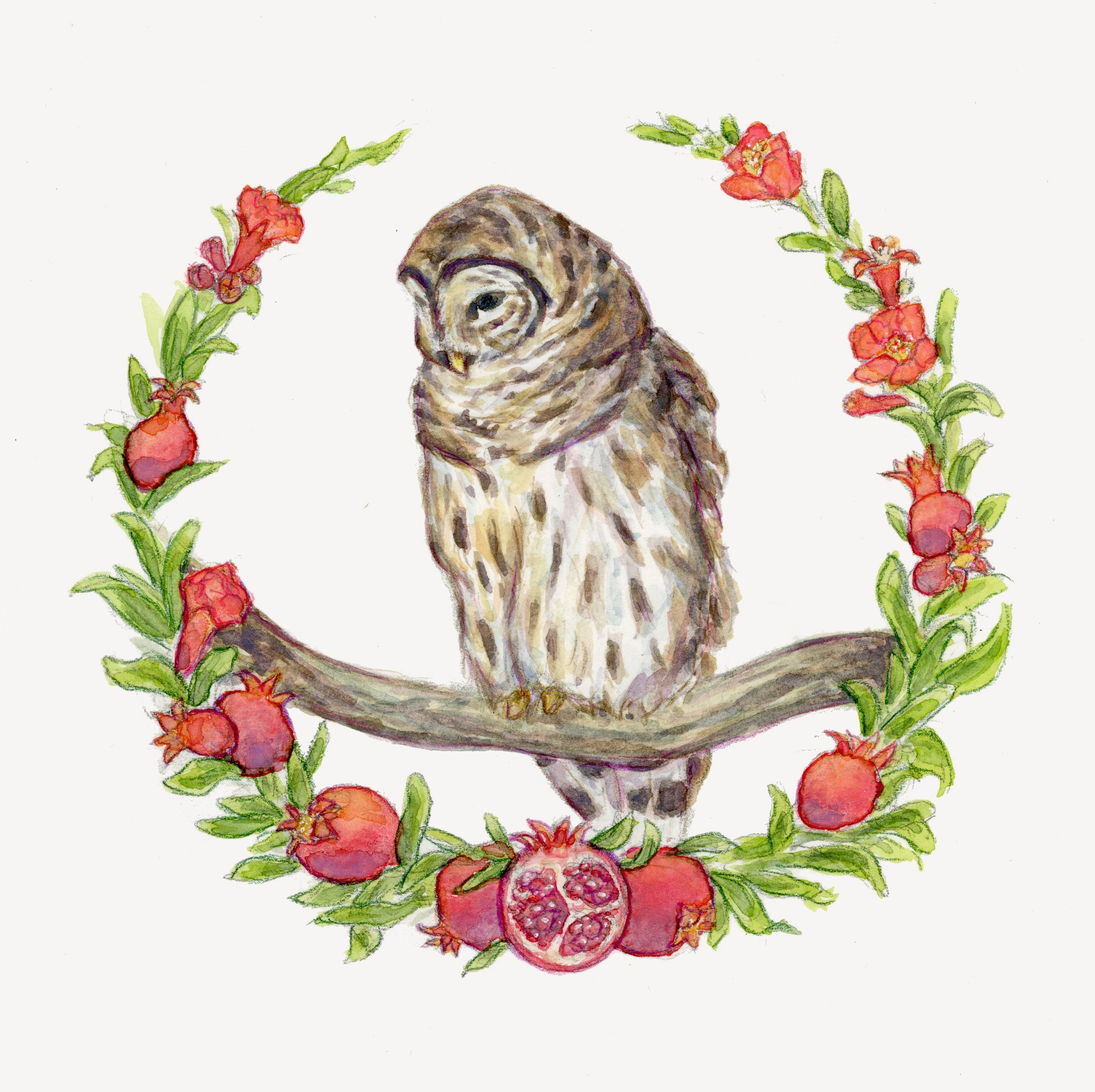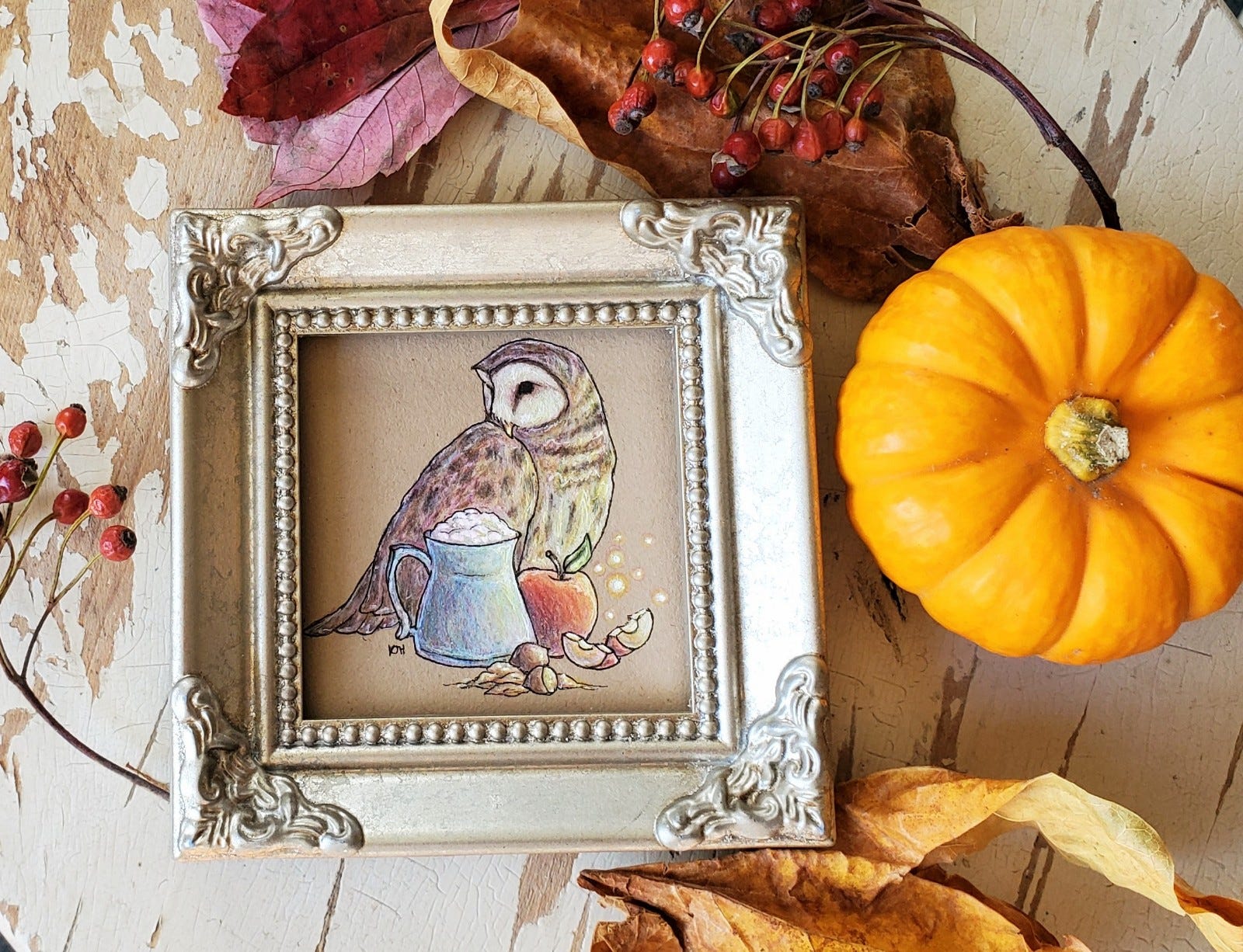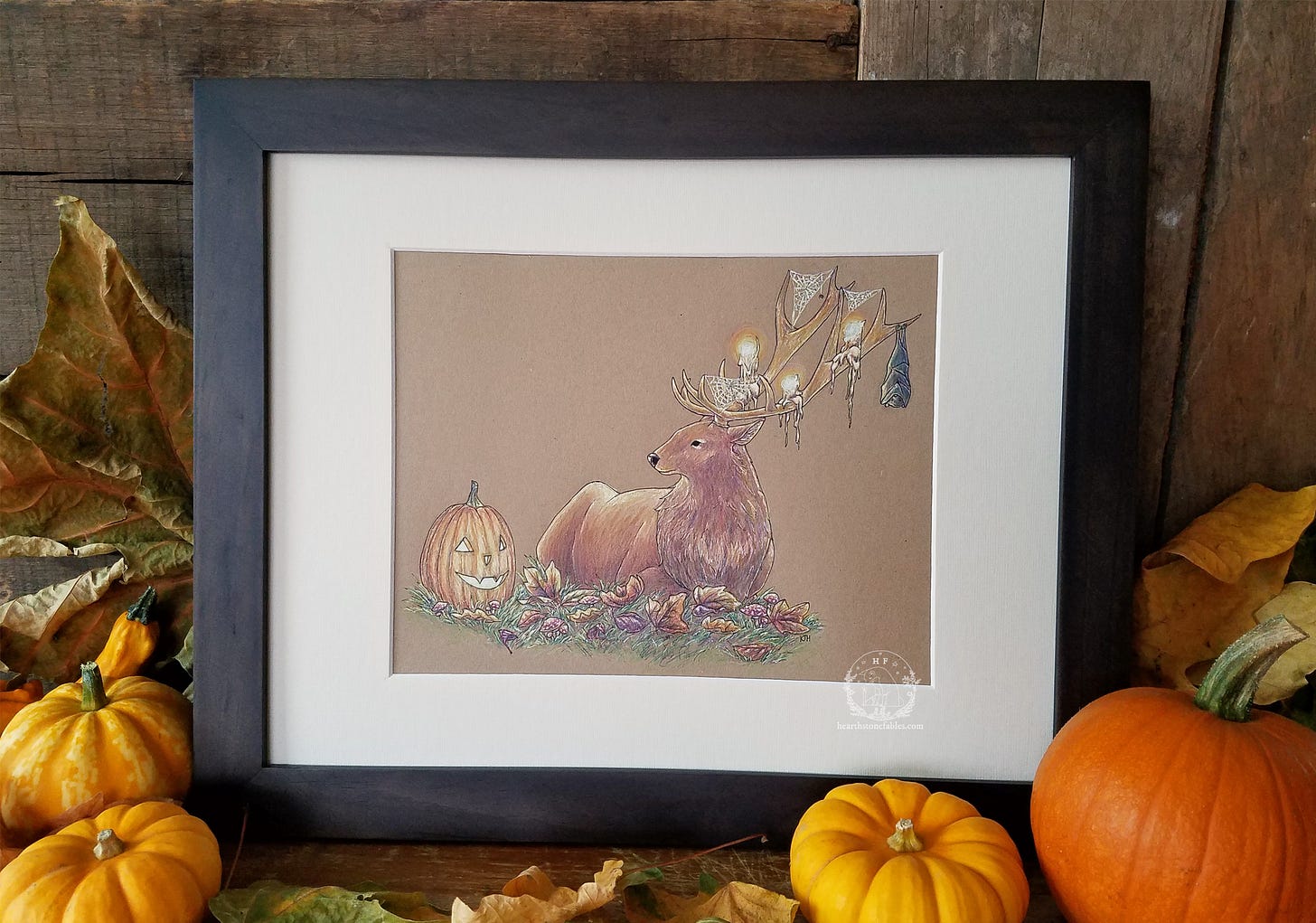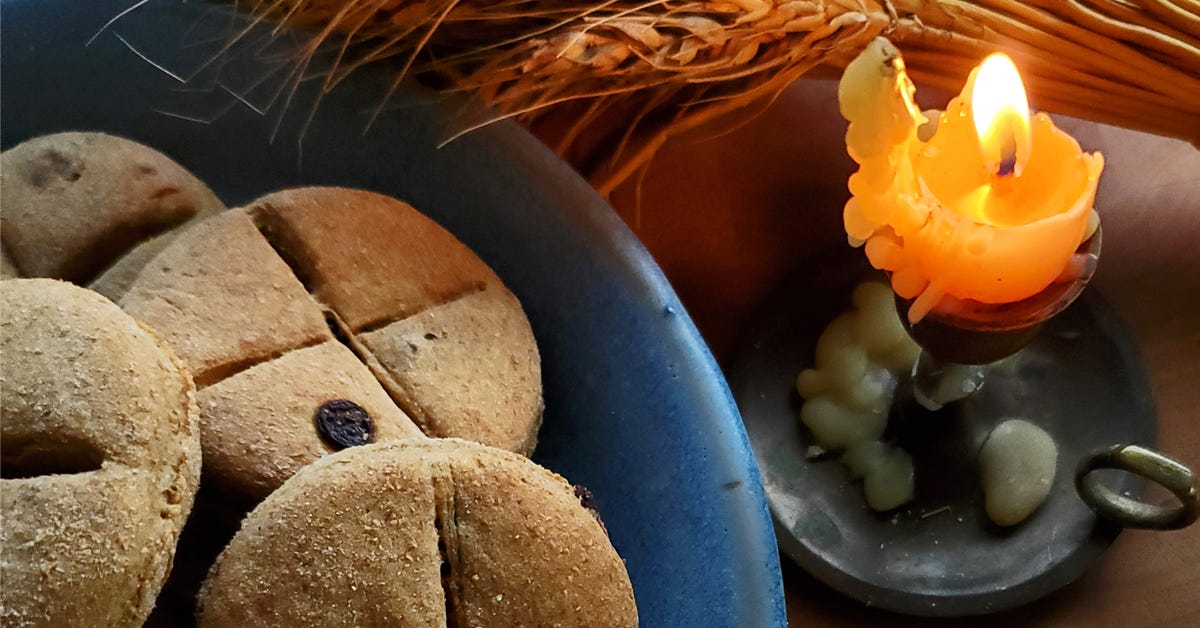on All Saints’ Day hard is the grain, / the leaves are dropping, the puddle is full
November 1: Hallowmas (Apples & Lambswool | Candlelit Mourning)
On All Saints’ Day hard is the grain,
The leaves are dropping, the puddle is fullAttributed to Llywarch Hen (534 – 608; prince of Brythonic kingdom of Rheged); translated by Dr. W. Owen Pughe (1792)
The solemnity of Hallowmas (All Saints’ Day) on November 1st traces its story to a 4th century commemoration of martyrs.1 Its date and focus shifted over the centuries, expanding to include not just martyrs, but all saints - those known and unknown spiritual ancestors who have been instrumental in forming and perpetuating the faith.
As I figure out my rhythm here in this space, my goal is to concentrate on one feast each month: the liturgical calendar can easily become overwhelming, and I want to keep a calm & thoughtful pace here. That being said, Hallowtide is extra special to me, and I can’t quite dig into Hallowe’en - the vigil of Hallowmas - without chatting about the rest of this triduum…so you’re hearing from me a bit more frequently this month!
These three days are bound together: All Hallows’ Eve prepares us for Hallowmas, which, in turn, shifts its focus toward its role as Soulmas Eve. This brief season defies our instinct to categorize the unknown into neat parcels.
“When, therefore, we honour the saints, in them and through them we honour God and Christ, the true God and true man, the Redeemer of mankind, born of the immaculate Mary, even Virgin, the King of the Saints, and the source of their glory and sanctity.”
Thomas Forster, loosely quoting Butler’s Lives in The Catholic Yearbook
In our time & place here in modern America, Hallowtide faces a difficulty similar to the twelve days of Christmas: we find that once Christmas Day is over, our world has completely moved on. Trying to maintain the celebration of those twelve days - to really explore the wisdom in that set-aside period of feasting - can feel daunting, since these days are, after all, not meant to be enjoyed in a vacuum but rather in a context of community.
Likewise, we encounter Hallowe’en at the end of October, and its crucial sisters of Hallowmas and Soulmas round the corner without much in the way of cultural support.2 For my own part, this has brought with it the challenge of asking myself: just how do I celebrate each of these holy-days in ways that have some sense of continuity and yet distinction, so that it’s not like I’m repeating Hallowe’en for three straight days (beloved though it is)?
Over time, I’ve found some prompts in Hallowmas celebrations of yesteryear - all of which point me back to attentiveness to our place and our people, putting everything within the larger context of the communion of saints. And, though Hallowmas has its own distinctiveness within this brief season, Hallowtide itself is fluid - the flavor of Hallowmas traditions mingle backward to its vigil & forward to Soulmas.
How did our predecessors engage with this solemnity? How did they see the theology of Hallowmas woven through the natural world around them, as well as in their familiar work and responsibilities?
For more on Hallowtide:
Fruit of the Fall
“On this day [Hallowmas], in many parts of England, apples are bobbed for, and nuts cracked, as upon its vigil, yesterday [Hallowe’en]; and we still retain traces of other customs that we had in common with Scotland, Ireland, and Wales, in days of old.”
William Hone, The Every-Day Book & Table Book (1826)
This time of year in the Pacific Northwest, we can’t safely wander beneath an old apple tree without dodging fruit as it falls to the ground. It’s a hey-day for the crows & ravens - they perch on the over-ripe apples and make short work of them, careless and haphazard because there’s so much fruit to be had. We have apple orchards strewn throughout the farm - some espaliered along trellising, others pruned like cones. Some are made into cider or other delights, others just enjoyed fresh and crisp.
But my favorite of all the apple trees here are a small cluster at one of the century-old homestead sites; gnarled, mossy, & tall, these old sentinels don’t get pruned or heavily harvested, but grow wild & drop any un-picked apples to the eager chickens & hogs (and eager apple-saucers, like me).
One of my favorite pastimes is hiking ghost towns, especially this time of year - and, out here in rainy Washington, that often means trying to make it through thick Fall undergrowth to spot any evidence of the former town.3
My kids have learned this art of clue-finding well: when we see a gnarled old apple tree, just a few fruit hanging from its branches, we know we’ve found the townsite and can expect to find some foundations nearby.
The timber buildings are long gone, but those apple trees remain as ghostly signposts.

Apples have become intermingled with an identity of home, often marking homeplace long after we’re gone. They’re a sign of cultivation. And as November arrives and I wade through fallen apples, the old Hallowmas traditions revolving around apples - enjoyed through both games and meals - make sense in such an intrinsic way.
Not only are apples the star of the season when Hallowmas arrives - they also bear with them our generational traditions and hopes. They feel redemptive, faithful.
“As an apple tree among the trees of the forest, so is my beloved among the young men. With great delight I sat in his shadow, and his fruit was sweet to my taste.”
Song of Solomon 2:3
In traditional symbolism, they’re simultaneously the forbidden fruit of the Tree of Knowledge4, as well as the fruit of salvation. The apple is the forbidden fruit that, when held in the hands of the Christ child in iconography, transforms into the very emblem of our salvation.
On Hallowmas especially, a fitting fruit indeed with which to toast the saints…those who have paved the path before us as they followed Christ’s redemptive footsteps.
Whether we mark Hallowmas by making something with the orchard’s gifts of the season, or just bite into a crisp apple from the market, this humble fruit can serve as a touchstone - a simple reminder of the continuity of faith history that precedes us.
If you’re up for a challenge & looking for an especially historic apple beverage for Hallowmas, though, here’s a classic, festive drink for you: lambswool!
“Lambswool is in Ireland an ingredient at the entertainments on All Saints Day, and is used to designate a compound, consisting of the pulp of roasted apples, mixed with sugar and nutmeg…”
The Extractor; or, Universal Repertorium of Literature, Science, and the Arts, Vol. I (1828-9)
Though lambswool5 (a hot spiced apple beverage, where the apples are roasted until their pulp looks like wool) is commonly associated with wassailing throughout Christmastide and Twelfth-Night festivities, it was also a favorite libation for Hallowmas - and rightly so. Apples from the previous night’s Hallowe’en games go into the pot for a comforting beverage as winter weather descends - and perfect for toasting the saints held especially close by your family. Just replace the ale with apple cider, and you have something that can be enjoyed by everyone!
“To make this beverage, mix the pulp of half a dozen roasted apples with some raw sugar, a grated nutmeg, and a small quantity of ginger; add one quart of strong ale made moderately warm. Stir the whole together, and, if sweet enough, it is fit for use. This mixture is sometimes served up in a bowl, with sweet cakes floating in it.”
The Curiosities of Ale & Beer: An Entertaining History by John Bickerdyke (1886)
Candlelit mourning
While bonfires and lanterns begin to light the sky on Hallowe’en, their presence becomes more noticeable as the triduum continues on. Hallowmas brought with it illuminated processions - funereal & festive in nature, somehow both somber and yet celebratory commemorations of the lives of the saints. Hallowtide is a time of paradox, after all, when death is both fearful and triumphant (an echo of what we see in the springtime Paschal triduum).
“The book of ceremonial for the court of Henry VII specified that upon All Saints’ Day the monarch would dress in purple and his attendants in black, the colours of mourning. For that evening, as the parish accounts indicate, many churches laid in extra supplies of candles and torches, to be carried in procession and to illuminate the building. Some in London arranged unusually elaborate entertainments as part of the service on that night; one such was St. Mary Woolnoth which in 1539 paid five maidens wearing garlands to play harps by lamplight. Each mayor of Bristol in the 1470s was expected to entertain the whole council and other prominent citizens and gentry, to ‘fires and their drinkings with spiced cakebread and sundry wines’, before they dispersed to their respective parish churches for evensong.”6
We even have the register’s account for Hallowmas festivities at St. Mary Woolnoth in the 16th century:
Item paid on Ahalowen day for V herps for virgyns to play
Item for garlandes for the same virgyns
Item for lampes for the same virgyns7
Hallowmas was also the event marking the return of winter’s tapered candles in church. As Candlemas (February 2) sees the blessing of candles and then the storage of church tapers as daylight lengthens, Hallowmas bears with it the return of church tapers:
“From Candlemas to Hallowmas, the tapers which had been lighted all the winter in Cathedral and Conventual Churches ceased to be used…”
Monthly Repertory of English Literature, Vol. XXIV (1818)
All of these celebrations coincided with the end of the harvest and the closing of another agricultural year. People put their produce in storage to nourish them during the long winter, and the Church set aside this same time for them to recall the faithful obedience of the saints - those who had stored their hope and faith within the mystery of God.
With the bulk of the harvest over and the nights growing longer and longer still, the bonfires, torches, candles, and lanterns illuminating the Hallowtide sky must have been a comforting, tangible reminder of all the saints - lights along the path, helping to illuminate our journeys.
Preparing the table for Soulmas…
As Hallowmas bends toward evening, it begins to shift its character toward Soulmas - we see tables being set for our familiar dead, and hearts & prayers turned toward them.
We’ll chat more about that soon…but in the meantime, you can prepare for Soulmas with the soul cake recipes I posted here:
Art + Resources
If you’d like some quick references for Hallowtide, hop into the Scriptorium:
How do you celebrate Hallowmas? What traditions have you noticed about this day that are especially meaningful?
If you’re not sure where to begin, consider picking some of the saints you resonate most with, and then learning more about the landscapes that formed their lives and the autumnal meals enjoyed in those places. It can feel a bit like sharing a table with them!
Pax vobis,
Kristin
If you’d like to make a one-time donation, I have a PayPal Tip Jar - please know that I’m so grateful for your monetary support, which really does help me continue to do this work that I’m so passionate about!
For those who are able to support a monthly or annual paid subscription, I offer occasional new printables, extra posts, and access to my whole library of printables: the Scriptorium. I’m so grateful for your generosity, which helps to support my work through the purchase of additional books for research, art supplies, and more!
For more reflections and perspectives on the liturgical year, please visit Signs + Seasons: a liturgical living guild!
For a brief timeline, take a peek at my previous Hallowtide post!
I’m making broad generalizations here, and of course just speaking from my experience! In many parts of the world, Hallowmas and Soulmas still maintain a strong presence, as we see in Día de los Muertos.
We always follow trails, but in the case of some ghost towns here - so overgrown in the forest - the trail literally disappears.
The reason for this association as the forbidden fruit stems from the Latin word for “apple” - malus - which is also the Latin for “evil.”
There’s a lot of debate about the etymology of “lambswool.” As is sometimes the case, assertions by previous folklorists became accepted as fact even though they were often based on inference. A common belief was that “lambswool” at Hallowmas is derived from the Gaelic La Mas Ubhail, “day of the apple fruit.” This theory has been brought into question, though, and it’s now thought that lambswool was named simply because its frothy appearance resembles wool.
Ronald Hutton, The Stations of the Sun
Excerpted from The transcript of the registers of the united parishes of S. Mary Woolnoth and S. Mary Woolchurch Haw, in the city of London, from their commencement 1538 to 1760.















I love this post so much. All these things have been on my mind so much lately, with the anniversary of my dad’s death approaching. I want to remember it in a more heartfelt and holy way. Also, I love the stuff about apples! I ran across a description of Lamb’s wool in a book called ‘England of Song and Story’ and made a version of apple juice, apple sauce and spices (and a hint of brown sugar). I love this season!
Mmm! The lambswool sounds delicious. I love the fact about the candles and the connection to Candlemas.